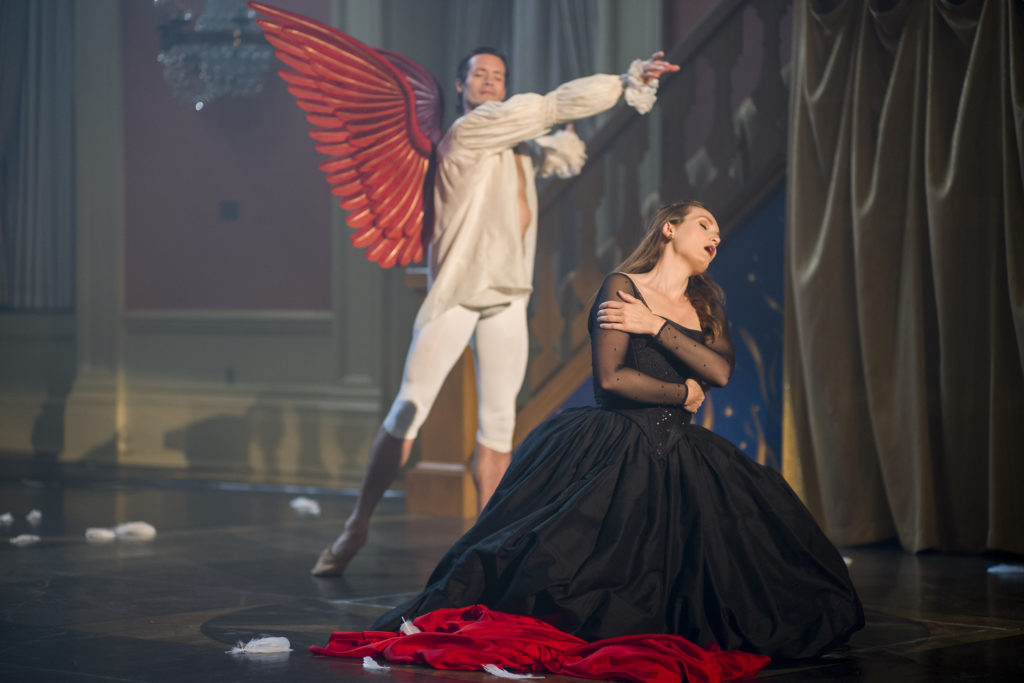Perhaps nowhere else than 18th century Rome could a nobleman, the Marchese Francesco Maria Ruspoli, commission and fund multiple performances of a lush oratorio calculated to satisfy the discerning appetites of entertainment-starved guests while simultaneously earning the approval of a particularly austere pope during the sombre Easter season.
Perhaps at no other time in his career did a then impressionable, musically ambitious 23-year old George Frideric Handel ever exceed quite the same level of breathless excitement and air of discovery as was to characterize this, the first uncompromising proof of his instinctive theatrical genius.
And perhaps no other visionary pair of early music impresarios other than Opera Atelier Co-artistic Directors Marshall Pynkoski and Jeannette Lajeunesse Zingg could realize all the intensity of expression, all the urgency, all the sweep of emotion of The Resurrection with such stylishness and vibrancy on the digital stage.
First scheduled to debut live at Koerner Hall in April 2020, reimagined as a streaming on-demand internet presentation in response to COVID-mandated theatre closures, rehearsals and production twice postponed by local lockdowns, Pynkoski/Lajeunesse Zingg’s gleaming evocation of Handel’s youthful masterpiece stuns and amazes. Premiered on small screens everywhere late last week, OA’s The Resurrection glows with vitality, a luminous assertion of the power of nimble, supremely irrepressible artistry to transcend the limitations of the often all too limiting 16:9 proscenium that has come to frame the experience of music theatre for so many months.
Shooting in the Victorian splendour of Toronto’s cavernous St. Lawrence Hall overhung by a veil of fog, mystery and chiaroscuro, Film Director/Editor/Director of Photography Marcel Canzona employs an edgy, at times unsettling mix of verité and fixed observation to capture the moody sweep of sacred circumstance following Christ’s interment. Related largely as impassioned narrative by three holy mourners, Mary Magdalene, Mary of Cleophas — an intriguing, less chronicled visitor to the Son of God’s tomb — and St. John the Evangelist, practiced poet and dramatist Carlo Sigismondo Capece’s altogether original libretto upholds the fundamentals of the central Christian narrative while, at the same time, relating it in distinctly otherworldly terms. A strutting, bombastic Lucifer does verbal battle with an Angel of God, adding a cosmic element to Christ’s acceptance of earthly sin and subsequent victory over darkness and death.
Handel clearly delights in the simultaneity of setting and story, cross cutting singer to singer, scene to scene, one layer of score yielding to the next with a pronounced almost cinematic feel for montage and rhythm. Pynkoski and Lajeunesse Zingg clearly share the composer’s enthusiasm for the overt duality of the drama.
The Resurrection may be oratorio but the intense play of human emotion is as deeply stamped into the proceedings as in any opera, an urgent, compelling quality that Pynkoski exploits with irresistible abandon, showcasing his compact troupe of singer actors in a fluid succession of intimate cameos. God and the Devil both reside in the details here. Mary of Cleophas (Allyson McHardy) and the Magdalene (Meghan Lindsay), reach out to one another, yearning for comfort, poignant gestures of helplessness and despair, never quite able to touch. St. John the Evangelist (Colin Ainsworth) strides across the frame in his long flowing frock coat, all breathless dash and fervour. Lucifer (Douglas Williams) forever primps and preens, fussing with his hair. Beware the sin of pride.
The infernal vs the divine, darkness vs light, wickedness vs righteousness — unlike The Resurrection’s mortal cast, Devil and Angel occupy an infinitely broader allegorical playing field. A masked legion of celestial warriors wielding rapiers makes God’s resolve to do battle against evil abundantly clear. Showers of dead leaves fall. The natural order is explicitly evoked. Piansero gli elementi/Del lor Fabbro immortal la morte fiera. (“The very elements have wept for the cruel death of their immortal Creator.”) Armfuls of lilies appear. Death and darkness have little lasting power. The Devil’s vow to deny Christ eternal life proves as empty as his boasting. With Christ’s resurrection, life is restored to the human world. Sunlight floods the hall. Sky blue banners flutter around the faithful as the heavens clear. All dance and rejoice.
Lajeunesse Zingg’s unfailingly spirited, swirling choreography, her precise tactical moves on Handel’s musical chessboard, amount to far more than mere spectacle and illustration. Like Pynkoski’s mirroring of the miraculous and the mystical via emblem and stagecraft, movement and ballet drive much of the primary dramatic impulse that is OA’s The Resurrection. What begins in sorrow and suffering with a band of soldierly angels ends in triumph and a surge of jubilation. Tyler Gledhill’s stately winged presence. Dominic Who’s ascendant Jesus. Lajeunesse Zingg’s infinitely gracious appearance as Mary Mother of God. All put fear to flight. Meticulous solos, refined pas de deux, intricate ensembles, Artists of Atelier Ballet consistently command and electrify, supremely eloquent storytellers in dazzling perpetual motion.
Appearing as The Angel, soprano Carla Huhtanen sings with heavenly richness, a remarkable voice of astonishing agility and range. Arie da capo sprout from virtually every node in Handel’s unapologetically flamboyant Italianate score. A master of coloratura, Huhtanen confidently sails through her fair share of intricate Baroque ornamentation with sparkling elegance.
Bass-baritone Douglas Williams is The Devil. (See above.) A blistering standout on the international Baroque scene, possessed of enormous poise and charisma, Williams unquestionably owns the role of Handel’s treacherous supervillain. This is a voice of remarkable potency and depth. Hypercharged. Explosive. Dangerously alluring.
The trio of Lindsay, McHardy and Ainsworth bring tangible notes of resonant human drama to the proceedings. Lindsay’s lovely Ferma l’ali, e sui miei fumi (“Fold thy wings, and o’er my eyes fly not, unwelcome sleep”), a gentle, poignant lament filled with love and bittersweet remembrance particularly entrances. Gifted with a deeper, denser mezzo instrument and a somewhat more direct approach, McHardy is no less effective, both artists splendidly well-balanced and complimentary. Their ardent Act I duet, Dolci chiodi, amate spine (“Sweet nails, beloved thorns”) demands careful note. As does the clarity of Ainsworth’s ringing tenor and his open, unaffected style. Though granted less opportunity for vocal virtuosity than the two Marys, Handel’s St. John the Evangelist is central to The Resurrection’s earthly vocal dynamic, his invincible high spirits and excitement counterpoint to the women’s somewhat more excruciating, intimate points of view. Ainsworth delivers a perfectly gauged performance.
Previously recorded at Koerner Hall in late winter of this year, a full period orchestra courtesy Tafelmusik conducted by David Fallis partners singers with great flair. Composed in 1708, Handel’s music for The Resurrection radiates enormous volumes of vitality and charm. Colours are fresh and glowing, harmonies and instrumentation highly inventive, the writing endlessly varied. Fallis and company obviously treasure every note, playing with flawless intonation and tireless animation.
Opera Atelier’s The Resurrection, the film, is, of course, very much a production of and for our times, ceaselessly resourceful. But one that also reaches far beyond the still prevailing grim pandemic reality of today. An expression of timeless beauty and grace. Indomitable. Transcendent. A film that journeys to the heart of abiding hope and faith. A glimpse of the always. A glorious shining waking dream.


